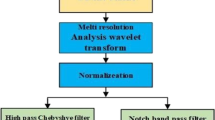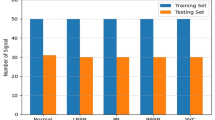Abstract
Towards the problem of ECG classification and disease prediction, various approaches are analyzed and discussed. However, the methods suffer to achieve higher performance in classification or disease prediction. To improve the performance, an efficient time series real time Naive Bayes ECG classification and disease prediction approach using fuzzy rule is presented in this paper. The method reads the ECG signals available and performs noise removal initially. From the graphs available, the features mentioned above are extracted and if there exist any incomplete or missing signal then the ECG sample has been removed from the data set. Once the preprocessing and feature extraction are done, then the features extracted. With the learned features, the method generates fuzzy rule for different disease class. The proposed algorithm computes posterior probability according to the mapping of different features of fuzzy rule. The classification or disease prediction is performed by measuring multi-feature signal similarity (MFSS). Estimated MFFS value has been used to measure the cardiac disease prone weight (CDPW) towards various classes available. According to the value of CDPW has been used to perform classification or disease prediction.












Similar content being viewed by others
Explore related subjects
Discover the latest articles, news and stories from top researchers in related subjects.Change history
19 May 2022
This article has been retracted. Please see the Retraction Notice for more detail: https://doi.org/10.1007/s12652-022-03914-w
References
Alarsan FI (2019) Analysis and classification of heart diseases using heartbeat features and machine learning algorithms. Springer J Big Data 2019:1–15
Alfaras M (2019) A fast machine learning model for ECG-based heartbeat classification and arrhythmia detection. Front Phys 2019:1–14
da Luz EJS, Schwartz WR, Cámara-Chavez G, Menotti D (2016) ECG-based heartbeat classification for arrhythmia detection: a survey. Comput Methods Prog Biomed 127:144–164
Diker A (2019) A new technique for ECG signal classification genetic algorithm Wavelet Kernel extreme learning machine. Elsevier Optik 180:46–65
Elhaj FA, Salim N, Harris AR, Swee TT, Ahmed T (2016) Arrhythmia recognition and classification using combined linear and nonlinear features of ECG signals. Comput Methods Prog Biomed 127:52–63
Garcia G, Moreira G, Menotti D, Luz E (2017) Inter-patient ECG heartbeat classification with temporal VCG optimized by PSO. Sci Rep 7:105–116
Ghorbani Afkhami R, Azarnia G, Tinati MA (2016) Cardiac arrhythmia classification using statistical and mixture modeling features of ECG signals. Pattern Recognit Lett 70:45–51
Huang H, Liu J, Zhu Q, Wang R, Hu G (2014) A new hierarchical method for inter-patient heartbeat classification using random projections and RR intervals. Biomed Eng 13:90–98
Kiranyaz S, Ince T, Gabbouj M (2016) Real-time patient-specific ECG classification by 1-D convolutional neural networks. IEEE Trans Biomed Eng 63:664–675
Krasteva V, Jekova I, Leber R, Schmid R, Abacherli R (2015) Superiority of classification tree versus cluster, fuzzy and discriminant models in a heartbeat classification system. PLoS ONE 2015:1–14
Ledezma CA (2019) A modeling and machine learning approach to ECG feature engineering for the detection of ischemia using pseudo-ECG. PLoS One 14:1–15
lsin A (2017) Cardiac arrhythmia detection using deep learning. Elsevier Precedia Comput Sci 120:1–13
Mar T, Zaunseder S, Martínez JP, Llamedo M, Poll R (2011) Optimization of ECG classification by means of feature selection. IEEE Trans Biomed Eng 58:2168–2177
Mykoliuk I (2018) Machine learning methods in electrocardiography classification. ACIT 2018:1–10
Pyakillya B (2019) Deep learning for ECG classification. IOP Conf Ser J Phys Conf Ser 913:1–14
Raj S, Ray KC, Shankar O (2016) Cardiac arrhythmia beat classification using DOST and PSO tuned SVM. Comput Methods Prog Biomed 136:163–177
Sultan Qurraie S, Ghorbani Afkhami R (2017) ECG arrhythmia classification using time frequency distribution techniques. Biomed Eng Lett 7:325–332
Vijayakumar K, Arun C (2017) Automated risk identification using NLP in cloud based development environments. J Ambient Intell Hum Comput 2017:1–15
Author information
Authors and Affiliations
Corresponding author
Additional information
Publisher's Note
Springer Nature remains neutral with regard to jurisdictional claims in published maps and institutional affiliations.
This article has been retracted. Please see the retraction notice for more detail:https://doi.org/10.1007/s12652-022-03913-x
About this article
Cite this article
Aarthy, S.T., Iqbal, J.L.M. RETRACTED ARTICLE: Time series real time naive bayes electrocardiogram signal classification for efficient disease prediction using fuzzy rules. J Ambient Intell Human Comput 12, 5257–5267 (2021). https://doi.org/10.1007/s12652-020-02003-0
Received:
Accepted:
Published:
Issue Date:
DOI: https://doi.org/10.1007/s12652-020-02003-0




